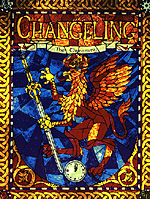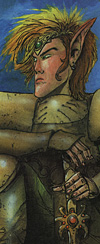
Title: Changeling: The Dreaming
Publisher: White Wolf Game Studio
Game Type: Roleplaying
Price: $25
Pages: 293
Number of Players: 2+
Requirements: Paper, pencil, polyhedral dice
Designers: Mark Rein-Hagen, Sam Chupp, Ian Lemke, with Joshua Gabirel Timbrook
White Wolf works hard over 293 pages to call Changeling: The Dreaming a "storytelling" game and not a role-playing game. In elaborate detail, you are introduced to a people called The Kithain, their feudal society, and their efforts to live in our "mortal" world while pining to return to the legendary world of Arcadia.
Five houses (Dougal, Eiluned, Fiona, Gwydion, and Liam) vie for power, and you assume one of nine "Kith" (character types) in the pursuit and use of "Glamour" (otherwise known as the magical energy for spells). You create a character by allocating points to nine attributes, 30 skill abilities, and a variable number of "advantages." Combat and other actions are determined by dice, as you roll a number of 10-sided dice (based on skill levels) trying to beat a "difficulty" number, which is sometimes altered by drawing random "bunk" cards. The more times you roll higher than the difficulty number, the greater the success of your action.
 So far, this is nothing out of the RPG (roleplaying game) ordinary--indeed, it is relatively painless system to learn. Note that you need to create your own cards, but the specifications are in the book.
So far, this is nothing out of the RPG (roleplaying game) ordinary--indeed, it is relatively painless system to learn. Note that you need to create your own cards, but the specifications are in the book.
But if that is all you see, you miss the point of a creative environment where the Kithain eventually must succumb to two fascinating concepts: Banality and Bedlam.
In this universe, our imagination, creativity, and dreams form the life force of existence, and as you grow older, you must fight the temptation to be practical, logical, and downright dull--not to mention becoming crazy, mad, or otherwise a few pips short on your dice. This is incredibly difficult to pull off in a RPG, but the White Wolf folks turn in an enlightened effort. Indeed, the possibilities are alarmingly within your grasp, even if the adventure in the back of the book is somewhat banal. There is cleverness at work here.
Chapter One-Ders: Changeling: The Dreaming: The Introduction
Back to List of Game Reviews: Sci-Fi, Fantasy, and Horror
© Copyright 1996 by Coalition Web, Inc.
This article appears in MagWeb (Magazine Web) on the Internet World Wide Web.
Other military history articles and gaming articles are available at http://www.magweb.com
